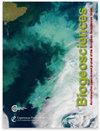瑞典北部亚北极泥炭地与永久冻土退化有关的甲烷排放升级的光学和雷达地球观测数据
IF 3.9
2区 地球科学
Q1 ECOLOGY
引用次数: 0
摘要
摘要北极地区的永久冻土融化正在增加向大气中的甲烷(CH4)排放,但由于受影响的地区广大而偏远,很难对这种排放进行量化。因此,地球观测(EO)数据对于评估永久冻土融化、相关生态系统变化和CH4排放增加至关重要。通常采用的方法是使用EO从现场测量中进行外推。然而,有一些关键的挑战需要考虑。景观CH4排放是一个复杂的局地尺度微地形和植被类型混合的结果,这些微地形和植被类型支持广泛不同的CH4排放,并且在植被转变发生之前很难检测到永久冻土退化的初始阶段。本研究考虑使用超高分辨率无人驾驶飞行器(UAV)数据和Sentinel-1和Sentinel-2数据的组合来推断一组植被类型的CH4排放的现场测量值,这些植被类型捕获了退化的palsa湿地植被的局部变化。我们表明,超高分辨率无人机数据可以绘制与CH4排放变化相关的植被空间变化,并在更广泛的景观中推断这些变化。我们进一步展示了如何将其与Sentinel-1和Sentinel-2数据集成。通过软分类和简单修正硬分类的误分类偏差,输出的植被制图和随后的CH4排放外推与使用无人机数据生成的结果非常吻合。干涉合成孔径雷达(InSAR)沉降评估和植被分类表明,高沉降率的palsa湿地可以用来量化CH4排放增加的风险区域。据估计,目前正在经历下沉的50公顷地区向沼泽植被的过渡将使排放量从每季116千克甲烷增加到每季高达6500至13000千克甲烷。本研究的关键结果是,不同类型的高分辨率和低分辨率EO数据的组合提供了估计在不久的将来易向CH4排放源过渡的植被类型所覆盖的大地理区域的CH4排放的能力。这为我们提供了一个机会,可以在空间和时间上对北极的甲烷排放进行测量和监测。本文章由计算机程序翻译,如有差异,请以英文原文为准。
Optical and radar Earth observation data for upscaling methane emissions linked to permafrost degradation in sub-Arctic peatlands in northern Sweden
Abstract. Permafrost thaw in Arctic regions is increasing methane (CH4) emissions into the atmosphere, but quantification of such emissions is difficult given the large and remote areas impacted. Hence, Earth observation (EO) data are critical for assessing permafrost thaw, associated ecosystem change and increased CH4 emissions. Often extrapolation from field measurements using EO is the approach employed. However, there are key challenges to consider. Landscape CH4 emissions result from a complex local-scale mixture of micro-topographies and vegetation types that support widely differing CH4 emissions, and it is difficult to detect the initial stages of permafrost degradation before vegetation transitions have occurred. This study considers the use of a combination of ultra-high-resolution unoccupied aerial vehicle (UAV) data and Sentinel-1 and Sentinel-2 data to extrapolate field measurements of CH4 emissions from a set of vegetation types which capture the local variation in vegetation on degrading palsa wetlands. We show that the ultra-high-resolution UAV data can map spatial variation in vegetation relevant to variation in CH4 emissions and extrapolate these across the wider landscape. We further show how this can be integrated with Sentinel-1 and Sentinel-2 data. By way of a soft classification and simple correction of misclassification bias of a hard classification, the output vegetation mapping and subsequent extrapolation of CH4 emissions closely matched the results generated using the UAV data. Interferometric synthetic-aperture radar (InSAR) assessment of subsidence together with the vegetation classification suggested that high subsidence rates of palsa wetland can be used to quantify areas at risk of increased CH4 emissions. The transition of a 50 ha area currently experiencing subsidence to fen vegetation is estimated to increase emissions from 116 kg CH4 per season to emissions as high as 6500 to 13 000 kg CH4 per season. The key outcome from this study is that a combination of high- and low-resolution EO data of different types provides the ability to estimate CH4 emissions from large geographies covered by a fine mixture of vegetation types which are vulnerable to transitioning to CH4 emitters in the near future. This points to an opportunity to measure and monitor CH4 emissions from the Arctic over space and time with confidence.
求助全文
通过发布文献求助,成功后即可免费获取论文全文。
去求助
来源期刊

Biogeosciences
环境科学-地球科学综合
CiteScore
8.60
自引率
8.20%
发文量
258
审稿时长
4.2 months
期刊介绍:
Biogeosciences (BG) is an international scientific journal dedicated to the publication and discussion of research articles, short communications and review papers on all aspects of the interactions between the biological, chemical and physical processes in terrestrial or extraterrestrial life with the geosphere, hydrosphere and atmosphere. The objective of the journal is to cut across the boundaries of established sciences and achieve an interdisciplinary view of these interactions. Experimental, conceptual and modelling approaches are welcome.
 求助内容:
求助内容: 应助结果提醒方式:
应助结果提醒方式:


